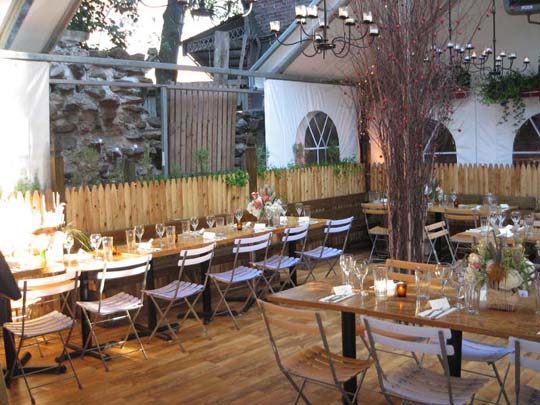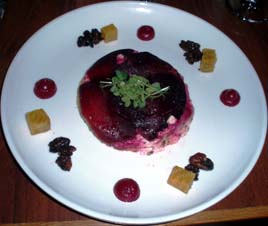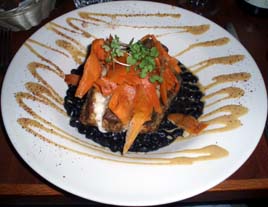The March 6th Village Voice carried an interview with Frank Bruni, in which he was asked what he would choose to eat for his last meal. His choices should come as no surprise to anyone familiar with the Times restaurant critic’s predilections: a porterhouse steak, toro-stuffed maki rolls like the ones they serve at Masa; and “some buttery taglierini with heart-of-season white truffles shaved over it. Just like you’d get in the Piedmont region of Italy, which is one of my favorite areas in the world for eating.”
Steak? Check. Sushi? Check. Italian food? Check. Those are the foods Frank loves.
But another phrase in the interview caught my eye: “my final meal wouldn’t be a fussy labor of extraordinary technique.”
Frank uses that word “fussy” a lot. I’ve found the word, in its various forms, in at least a dozen of his restaurant reviews. (He has also used it in articles about other subjects.) I thought this was a little remarkable, because “fussy” isn’t all that common a word.
“Fussy” is never a compliment: no one aspires to be “fussy.” And Bruni virtually always uses it to describe high-end luxury dining, a niche of the restaurant industry for which he has very little use. I don’t think it’s a coincidence that Bruni associates “extraordinary technique” with “fussy labor.” Perhaps there is extraordinary technique that Bruni doesn’t consider fussy, but judging from his reviews you’d be hard pressed to identify it. Fussy, starchy, stuffy, effete, highfalutin’ — those are the words Frank usually uses for fine food presented in luxurious surroundings.
For those who wish to keep track, here are all the Bruni uses of fussy (and its variants) in restaurant reviews:
Review of Anthos (16 May 2007):
And with Ms. Arpaia he opened Anthos, the restaurant you might get if you triangulated between Onera and Dona. It has the former’s resoundingly Greek soul. It has the latter’s fussy tics and more sophisticated wine list, with sommeliers who can guide you through the impressive advances of Greek winemaking.
Review of Momofuku Ssam Bar (21 February 2007):
By bringing sophisticated, inventive cooking and a few high-end grace notes to a setting that discourages even the slightest sense of ceremony, Ssam Bar answers the desires of a generation of savvy, adventurous diners with little appetite for starchy rituals and stratospheric prices.
They want great food, but they want it to feel more accessible, less effete. They’ll gladly take some style along with it, but not if the tax is too punishing. And that’s what they get at Ssam Bar, sleek, softly lighted and decidedly unfussy.
Double-review of Bar Room at The Modern and Eleven Madison Park (10 Jan 2007):
The Modern is divided into a fussy dining room and a more freewheeling bar area, where the food is less expensive, though not really and truly cheap.
Review of Freemans (20 September 2006):
[The server] said we needed to give our whole order at once, so our meal could be properly paced and we could have “a much more pleasant experience.” Of course that prohibition had nothing to do with our enjoyment and everything to do with the kitchen’s convenience. It also had no place in a restaurant as studiously unfussy as Freemans, but it exemplified the real attitude here.
Review of A Voce (10 May 2006):
It was just a matter of time before the right financial backers beckoned and Mr. Carmellini struck out on his own. The only real question was what shape that venture would take.
Would it be French and somewhat fussy? Mr. Carmellini had as much of that as of anything else in his background. Before Café Boulud, he worked at Lespinasse and Le Cirque.
Review of Del Posto (1 March 2006):
The ceremony surrounding main courses can indeed be fussy, with glistening slabs of flesh exhibited in their cooking vessels for adoration before being taken away and plated.
Diner’s Journal write-up of BLT Prime (24 June 2005):
The L and T mean Laurent Tourondel, whose manifest destiny is to attach his monogram to a great many B’s. The B means bistro, which none of the BLT restaurants really are. The word, or rather letter, serves to signal that an unfussy format accompanies Mr. Tourondel’s very fine food.
Review of Cookshop (30 November 2005):
The food is amply portioned, fairly priced and completely sophisticated but not remotely fussy.
Critic’s Notebook, “The Contemporary Dining Scene, Est. 1985” (12 October 2005)
About the same time [1985], a graduate of hotel and restaurant management school named Drew Nieporent and an emerging chef named David Bouley began their own experiment. Their goal was to recast the first-rate, fussy, uptown French restaurant as an affordable, approachable refuge with a downtown address, wines from California as well as France, and prices within reach of people who were not rich.
Review of Café Gray (15 December 2004):
The ambience doesn’t really suit the food, much of which is more ambitious and fussier than cafe or brasserie fare.
Review of En Japanese Brasserie (24 November 2004):
Even En’s identification as a Japanese brasserie suggests a have-it-all, connect-the-dots sensibility: it wants both the healthful allure of an ethnic cuisine in continued ascendance and the timeless appeal of an unfussy, teeming environment in which you can pass many a merry hour with copious drink as well as food.
Diner’s Journal write-up of The View (29 October 2004)
Both were more successful than an oyster and clam plate and a goat cheese terrine, the fussy presentations of which were undercut by the humdrum reality of how they tasted.
Review of Mas (7 July 2004)
Mas is the kind of earnest, tasteful restaurant that this city — that any city — can always use. It nicely splits the difference between fussy and unfussy.
The review of Mas, which contains his first known use of the word after becoming chief restaurant critic, is also the only time that he used the word “fussy” while making a compliment.
 Wednesday, March 14, 2007 at 07:43AM
Wednesday, March 14, 2007 at 07:43AM  Nish,
Nish,  Wayne Nish in
Wayne Nish in  BruniBetting
BruniBetting 










 After the concert, we came back for dessert. I was rather lax in my note-taking, but I believe this was the Warm Apple Tart ($7), which was wonderful: the best thing I had all evening.
After the concert, we came back for dessert. I was rather lax in my note-taking, but I believe this was the Warm Apple Tart ($7), which was wonderful: the best thing I had all evening.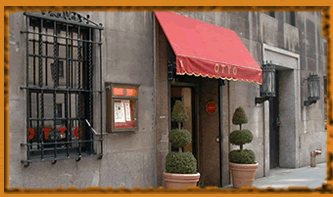
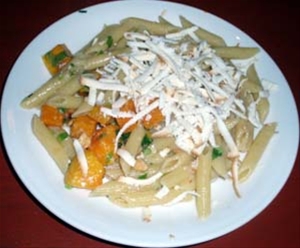 As I wasn’t very hungry, I ordered only the Penne con Noci e Zucca, with hazelnuts, butternut squash, and smoked ricotta. It was prepared with a light touch, with the flavors pleasurably balanced.
As I wasn’t very hungry, I ordered only the Penne con Noci e Zucca, with hazelnuts, butternut squash, and smoked ricotta. It was prepared with a light touch, with the flavors pleasurably balanced.